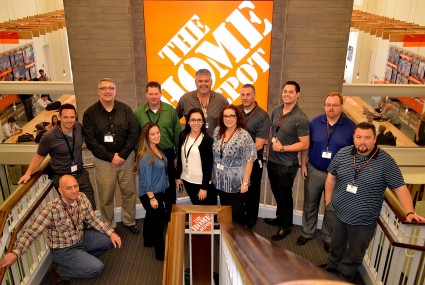Attendees Discuss Safety and Loss Prevention at Home Depot Supply-Chain Conference
Meeting brings together AP team from across logistics channels.
LP Magazine was pleased to be invited to attend the 2016 Home Depot supply-chain conference held at the Store Support Center in Atlanta in early October.
Mike Combs brought members of his team in for two days of training and knowledge sharing about logistics and loss prevention at Home Depot. Solveig Siliezar, an asset protection manager from Mira Loma, said she was looking forward to connecting with her peers. Being part of an AP team that oversees AP in five buildings, she feels this meeting is key to leverage the knowledge and experience of the team to help resolve issues she experiences. The audience included APMs from the different logistics channels (distribution centers, transit facilities, etc.) and even the latest acquisition, Crown Bolt, which includes Interline Brands… Read the full article.
LP101: Supply-Chain Management
Retail doesn’t start and stop at the front door of our stores, and ultimately our value depends on our ability to broaden our influence while protecting every aspect of the business enterprise. Supply chain management is a critical component of the retail machine. And while we may view the heart of retail as the interactions and events that happen within the store, this support system fuels the way.
Through a complex web of processes and activity, a well-managed supply chain is absolutely essential to a successful retail operation. Merchandise doesn’t magically appear on the shelves of our stores and into the hands of our customers. When we consider that every single piece of retail merchandise must in some way pass through the supply-chain network, it’s easy to see the need to implement appropriate controls and protect our interests as product moves through the supply chain… Read the full article.
Is Warehouse Burglary Becoming an Epidemic?
Loss prevention professionals need to be aware.
Most retailers run at least one (and often many) major warehouse operations. Some have a loss prevention arm specifically dedicated to supply chain security and safety. But for many in LP, the warehouse is rarely top of mind, and the subject of warehouse burglary doesn’t come up often. In fact, an older National Retail Crime Victimization Survey listed 18 million property crimes between 2004 and 2008 and only 18,000—or 0.3 percent—of these occurred in a warehouse. The media continues to report a general downward trend in property crimes, and I was unable to find more recent warehouse burglary data.
If you type “warehouse burglary” into a Google search, however, you would be led to believe this type of incident is reaching epidemic proportions. Page after page of results describe warehouse burglary incidents in news reports and articles. Most descriptions are short and garden-variety, but there are a lot of them, and they are recent… Read the full article.
Cargo Theft: Not Just a US Problem
Supply chain security issues plague multiple countries around the world.
Mexico’s number of cargo thefts grew 73 percent in 2015. According to FreightWatch International’s supply chain report, 1087 incidents were reported. Northern Mexico’s cargo thefts rose significantly, although the central zone states of Puebla, Guanajuato and the State of Mexico remain the highest risks. Food and drink continue to be the most stolen items, accounting for 18 percent of all cargo theft. Fuel cargo was subject to multiple hijackings in transit. Warehouse robberies were also a common theft method. Mexico reports at least three cargo theft incidents per day, versus two in the U.S.,, and the Mexican trucking industry is miniscule compared to that of the United States. August through September continue to be months with the most supply chain security issues in Mexico… Read the full article.
Supply Chain Asset Protection’s New BFF, “The Omni-Channel Experience”
Leading companies аrе dеvеlоріng business mоdеlѕ that fосuѕ on mаxіmіzіng сuѕtоmеr satisfaction.
With the growing significance of digital advertising and the advent of viewer customization and data mining, marketing to the same person in multiple touch points is a must for businesses today. While almost all of the tech-savvy retailers have decided to embrace multi-channel marketing, there are few to take full advantage of the specific characteristics of each channel and the interaction between them. In our world of supply chain asset protection, the tentacles continue to extend outwardly.
What we call “omni-channel” marketing is known for creating a consistent, interdependent customer experience across several channels. It is what every company aiming to succeed in an Omni-channel world should strive to achieve. Each channel must be able to meet the customer demand and be cost-effective (and so should the SCAP program). Nevertheless, one can venture into some particular channels so that overall customer/consumer experience can improve. Increased pressure from the pure online retailers are making the traditional brick-and-mortar businesses to fashion out strategies for them to retain market share not minding the cost implications and how it will affect their day-to-day activities… Read the full article.
